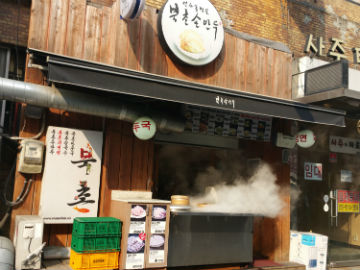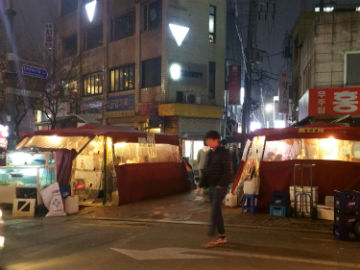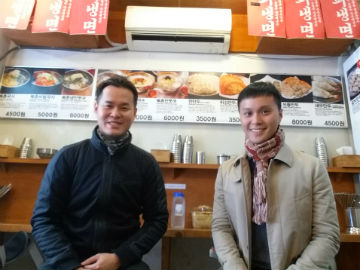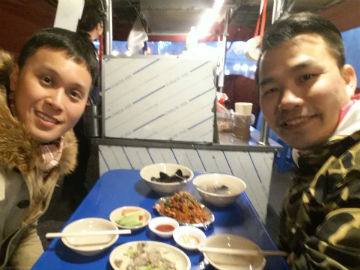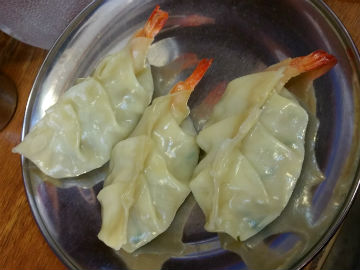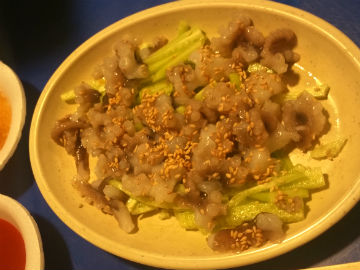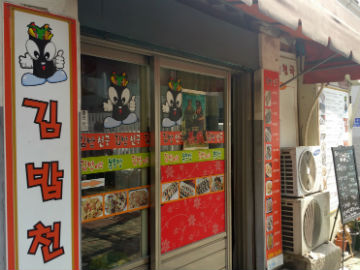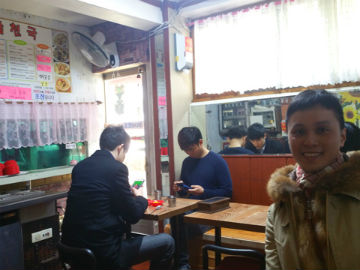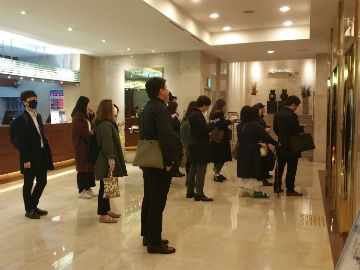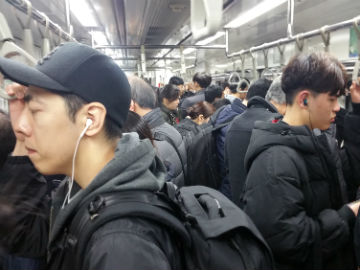|
South Korea |
March 2018 is my second time visiting South Korea, while my first one
was only a stop-over exploration. Locating between China and Japan,
South Korea’s culture is a combination of both,
yet I see some uniqueness stands out in this 5 days in the country. What
a good memory. 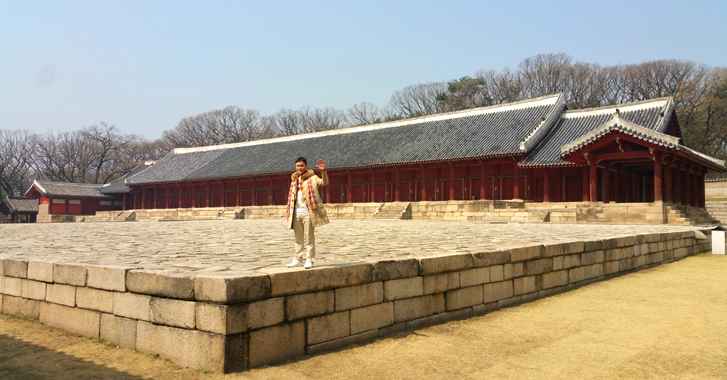 The place I enjoyed the most in Seoul this time is Jongmyo Shrine (宗廟), a UNESCO site and the royal clan temple of the Joseon Dynasty (朝鮮朝代), as my friend, Edmund, and I explored the site exclusively, undisrupted, with a guide for 1.5 hour. |
|||
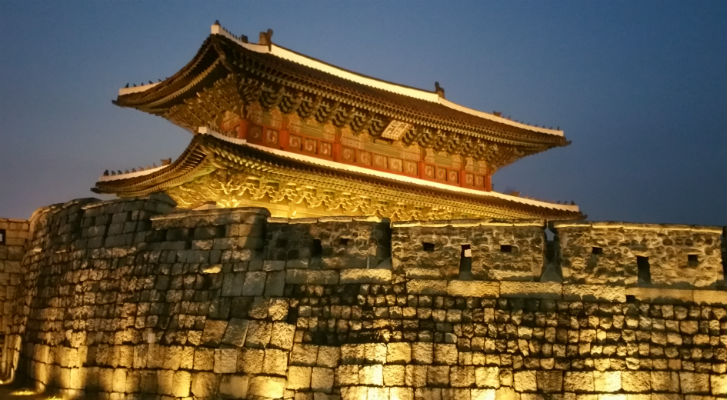 The signature of Seoul would be Dongdaemun, (東大門), or formally Heunginjimun (興仁之門), as it is the old eastern gate of the city still stands. |
|||
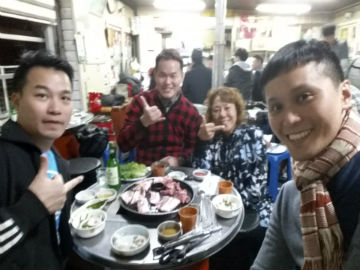 Edmund accompanied me for this Seoul trip, and in a surprise we bumped into Tin, a frequent Seoul visitor, on our first day, so he became our travel buddy and local guide for the trip. Thanks. |
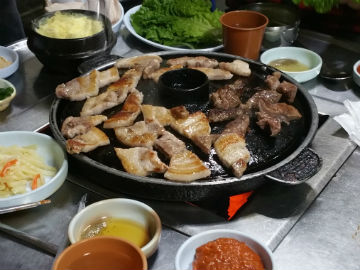 We tried Korean BBQ at local Jong-no area, ordered without English menu,and mingled with the locals. Definitely madeus feel like Seoulites. |
||
|
Joint Securities Area(JSA) and Demilitarized Zone
(DMZ)
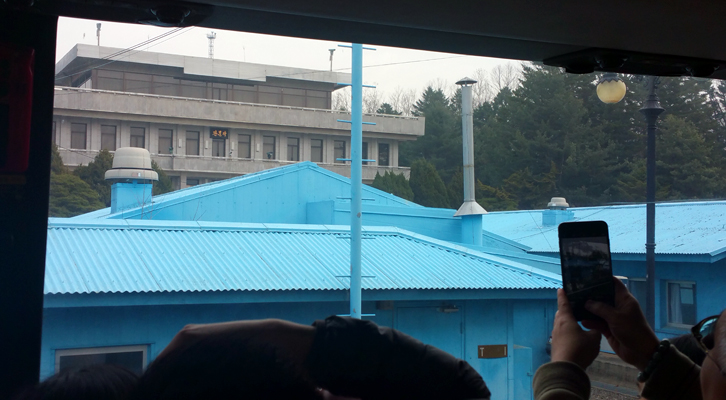 These blue buildings, belong to South Korea and allies, lie right on the border between North and South Korea. The grey building north of the blue houses is Panmun-guk (板門閣), North Korea's palace facing the demarcation line. On March 28, 2018, we were supposed to walk around the JSA and enter the blue house to cross the border into North Korea. Yet, early in the morning news broke that North Korea Leader Kim Jun En concluded his first ever foreign visit trip to Beijing. Security measures restricted us from leaving the military coach so our tour of the JSA concluded in a mere minute. |
|||
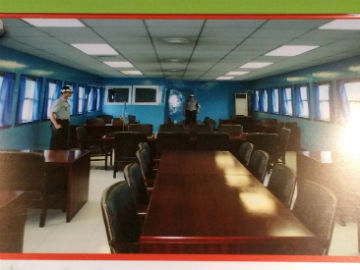 The blue houses named T1, T2,T3are the conference rooms straddling the border. This picture is what the inside should look like. We should be free to walk around the conference room and can hop from South to North. If we open the door to the North, perhaps we couldn’t return back to South Korea again. Both South and North Korean soldiers were supposed to be in an intentionally intimidating poses guarding in and around the rooms. However, as one of the North Korean soldiers defected and crossed to South Korean side in November 2017, North Korea had withdrew her soldiers. |
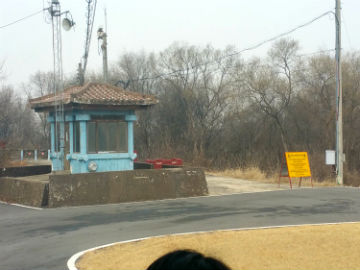 Inside the JSA is also the Bridge of No Return. After the Korean war, some prisoners of war were given the choice to cross over the bridge or to stay on the side of their captors, hence the name. The bridge is now closed and a new bridge to the north is used instead. Usually visited from the South only. |
||
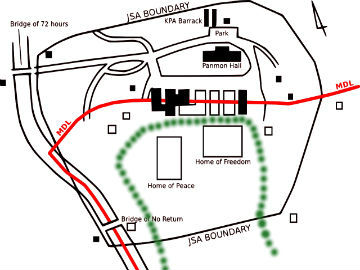 The Joint Security Area (JSA) is an almost circular patch of land with an 800-meter diameter. The area is jointly policed by the South and North, and the two sides occasionally meet for discussions (or gunshots). Most of the time the soldiers glare at each other across the border and have not been allowed to cross the demarcation line into each other's side since 1976. The red line is the border between North and South Korea and the green dotted line was our one minute tour of the JSA on the UN military coach. |
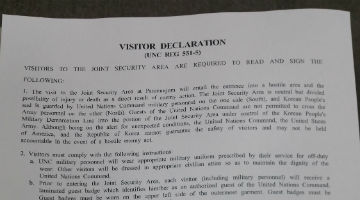 The Demilitarized Zone (DMZ) is a 4 km buffer along the north and south sides of the Military Demarcation Line (2 km into North Korea and 2 km into South Korea). The JSA is a tiny area inside the DMZ. From the South, entry into the JSA/DMZ requires signing a voucher where we need to agree to accept responsibility for "injury or death as a direct result of enemy action". It is technically an active war zone. |
||
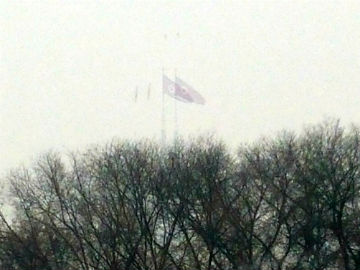 TheKijong-dongon the North Korean side of the DMZis a former village built up with fancy apartment blocks and a 160-meter flagpole entered in the Guinness Book of World Records as the world's tallest — but nobody lives there, hence its common name "Propaganda Village". Entry into the village is not permitted, but it is clearly visible from the JSA. |
 Within the DMZ, photography outside designated points is not permitted, even from the tour bus. It’s the last picture I took over the North Korea side. However, the DMZ is an area definitely worth taking pictures as it is preserved as a war zone (indeed, it is). War trenches, shoveled earth and dried trees are visible. |
||
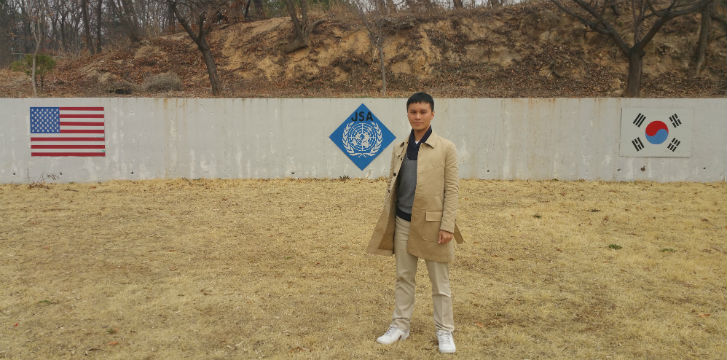 The DMZ of the South Korea side is patrolled under South Korea military force, U.S. military force and United Nation Command. Passport checked is required and Koreans are not allowed to visit the area. The DMZ is the most heavily armed area in the world with pillboxes, land mines, barbed wire, and tank stoppers line the entire border and stretch back halfway to Seoul in the South and Pyongyang in the North. |
|||
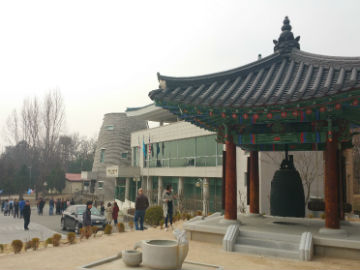 Camp Bonifasis the US/South Korean military base near DMZ. Visitors to Panmunjeom will change to military coach and get briefed here before entering the DMZ. Travel within the DMZ is possible only in UN vehicles, accompanied by a soldier who will serve as a tour guide in the JSA. |
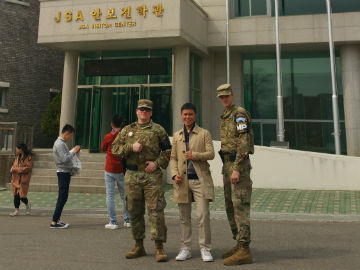 The soldier on my right is our guide at DMZ/JSA. On his first day of duty, explosion occurred at night which could have been an attack. It turned out to be bird landed on a mine. Of his 12 months here, there had been 12 explosion like this. He told us millions of mines had been set at DMZ. He also shared with us the story on the North Korean soldier defector in November 2017 and the phone rang from North Korea first time in 20 plus years to hold a talk in February 2018. What a history. |
||
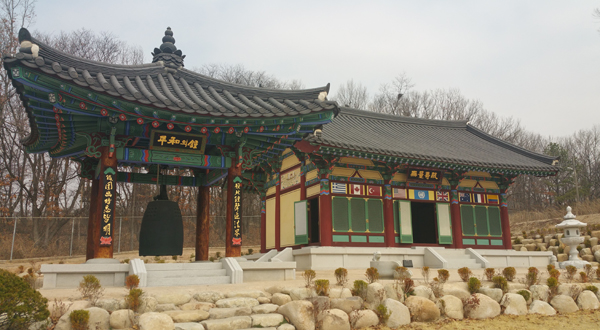 |
Muryangsujeon Hall (無量壽殿)and Bell of Peace (和平之鐘) were meant to heal Koreans’ pain of separation, to pray for the peaceful unification and to honor the fallen heroes from the 16 countries/states supporting the South on the Korean War . Total killed/ wounded on both sides is estimated at 2.5 million. |
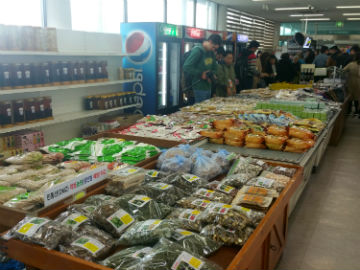 A shop inside the DMZ which sell JSA/DMZ and North Korea souvenirs and also produces from Taesong-dong, a South Korea's showpiece "Freedom Village" inside the DMZ. Yellow beans and rice are the signature products here. Yellow beans grown here had been the fuel source during the war. |
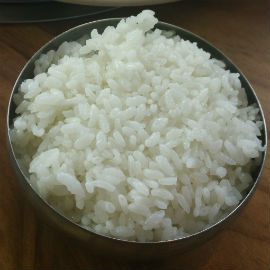 The
Freedom Village containing a little over 200 farmers working under
24-hour military guard. They are the highest paid farmers in the world
with monthly salary of USD10,000 along with shared proceeds from
sale.All the then villagers died during the war. Only the decedents of
the original villagers can become a member of the village, unless it’s
by marriage (women only). There is daily curfew and the villagers must
spend 300 nights inside the village to maintain the residency. Entry
into the village is not permitted.
The
Freedom Village containing a little over 200 farmers working under
24-hour military guard. They are the highest paid farmers in the world
with monthly salary of USD10,000 along with shared proceeds from
sale.All the then villagers died during the war. Only the decedents of
the original villagers can become a member of the village, unless it’s
by marriage (women only). There is daily curfew and the villagers must
spend 300 nights inside the village to maintain the residency. Entry
into the village is not permitted. |
||
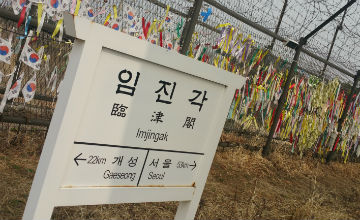 Imjingak(臨津閣), 7 km south of the DMZ, is an observatory with views across the ImjinRiver towards the DMZ and North Korea. The then train line to Pyongyang also passes here. |
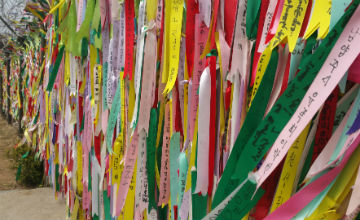 This is the closest South Korean can get to the DMZ without security clearance. Throughout the 60+ years families had been split between North and South without any contact. These slips represent the greetings and regards sent by the South to the northern relatives. |
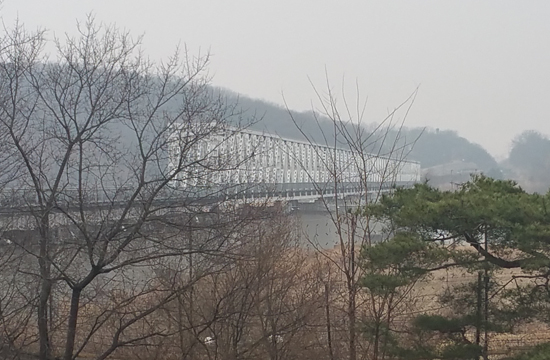 |
Bridge of Freedom does actually cross the Imjin River. It is a former railroad bridge which was used by repatriated prisoners of war and soldiers returning from the north. I questioned whether South Koreans want unification. The answer isn't a solid yes... It's mainly taking the point of view of political, cultural and economical. The North has established a tough stance, could there be reconciliation? |
| It's been almost 70 years of lost contact, not many in the South still remember the lives of the North. The cultural and economic difference is huge, can the North handle the free market and expensive South? Can the South support the North? |
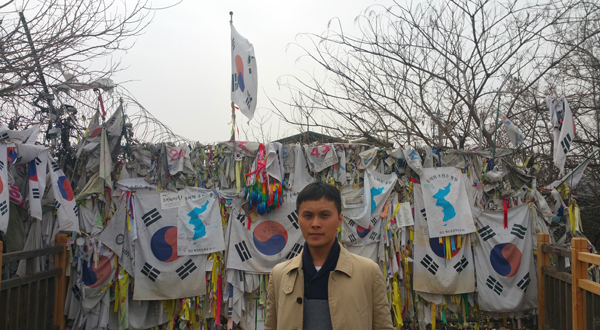 |
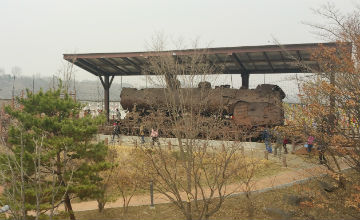 The steam locomotive used to go to Sinuiju before Korea separation. It was on its way to Pyongyang from Gaeseong, transporting military supplies prior to attack from Chinese military. |
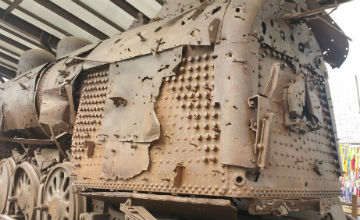 The old rusty locomotive has more than 1,000 bullet holes and the wheels are tilted. Since being bombed and derailed during the Korean War, the steam locomotive has remained in the same spot for more than 60 years. |
||
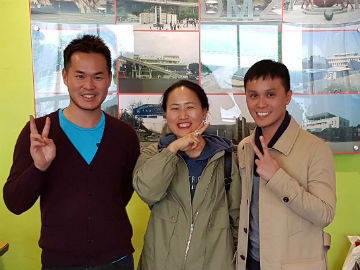 Only 5 tour companies can operate the DMZ tours. We joined KTB Korea Travel Buerau tour. The DMZ/JSA tours do not operate daily and the schedule is actually random depending on military schedule. She is our tour guide whose father is from Pyongyang and mother from Seoul. |
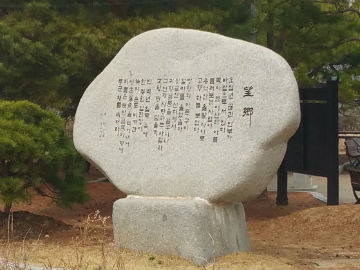 She told us quite some stories related to North Korea. An emotional one would be about her father who fled Pyongyang to Busan at age 17 and could never gone back home. His last few words on his deathbed was “mom, mom”. 望鄉 |
|
Seoul City |
|||
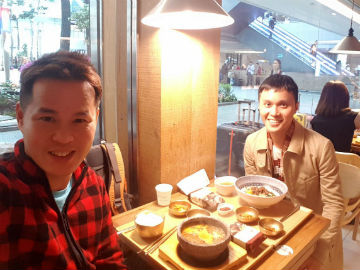 Our first meal at Seoul airport – bibimbap. |
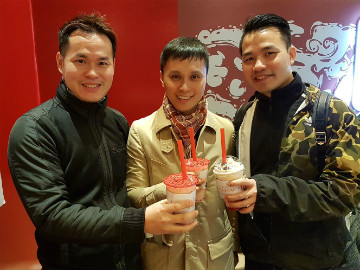 Strawberry bubble tea. |
||
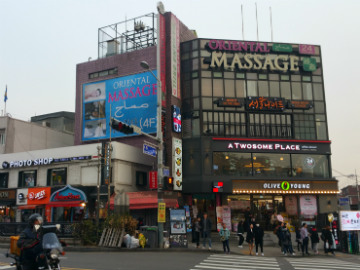 We spent the weekend staying at Itaewon (梨泰院). |
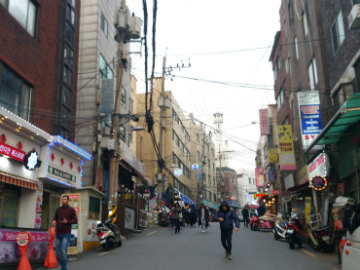 The town is quiet in the morning. |
||
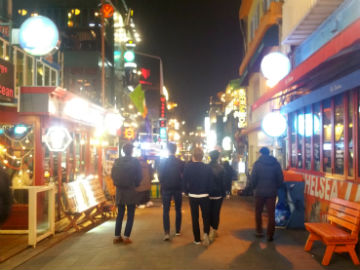 Wait until it’s at night where the action comes. |
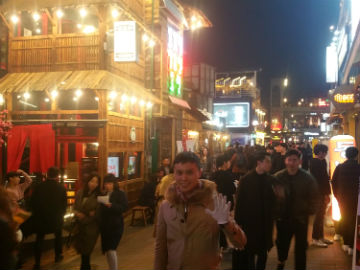 As the American military base is near the area, Western pubs and bars are nearby. |
||
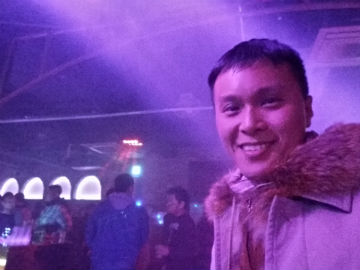 Of course we went clubbing. As metro won’t start until 5:30am, local’s clubbing hour starts at 1am to 5am. |
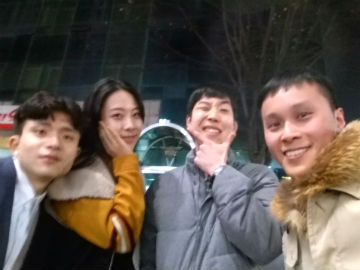 Met some locals there, yet their level of English proficiency is like me speaking Korean. No communication at all… So I will skip... |
||
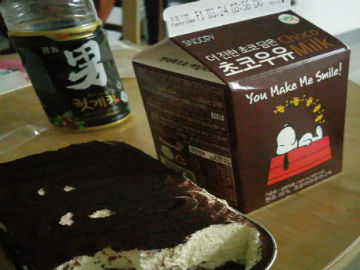 My dessert for the night at 4am. |
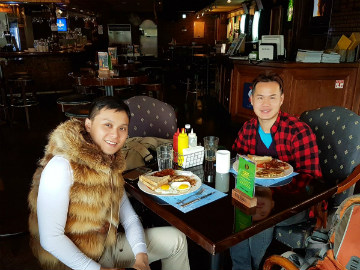 After two nights of hard clubbing, we ought go back to western food. English full breakfast!!! |
||
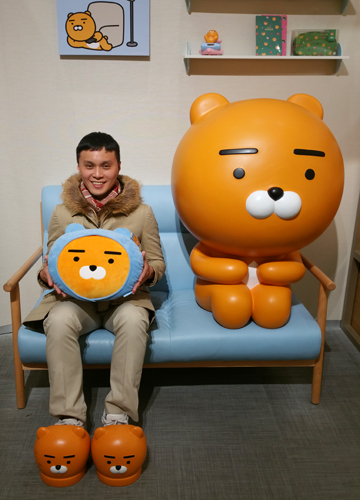 Some new Korean cartoon character |
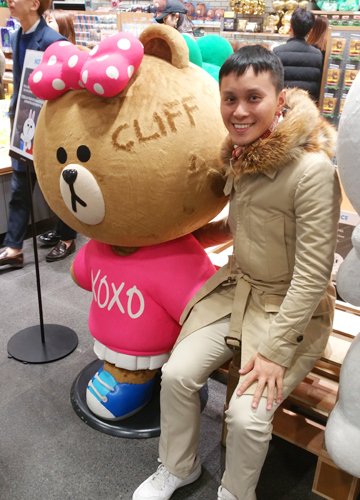 Line town |
|
Gangnam
(江南) Style at Coex. |
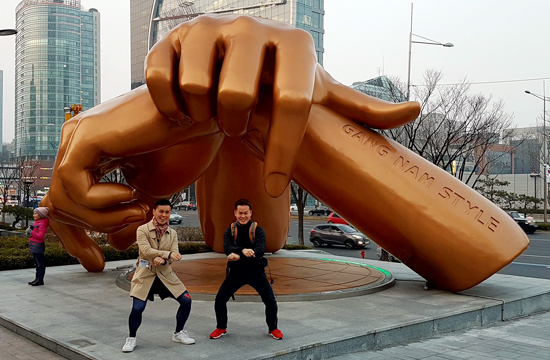 |
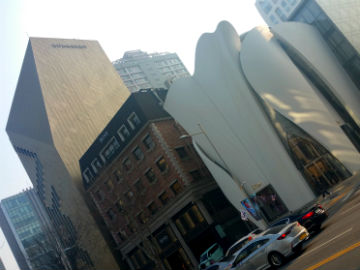 Apgujeongdong(狎鷗亭),home to hundreds of luxury brands. Here is Burberry, Hugo Boss and Dior buildings. |
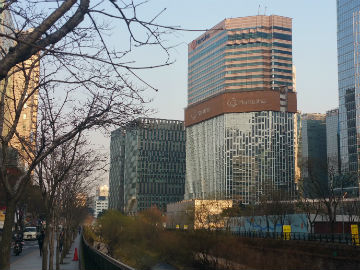 City Center. They are transforming an old building into mirror exterior. |
||
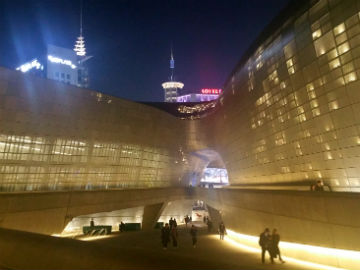 Dongdaemun Design Plaza |
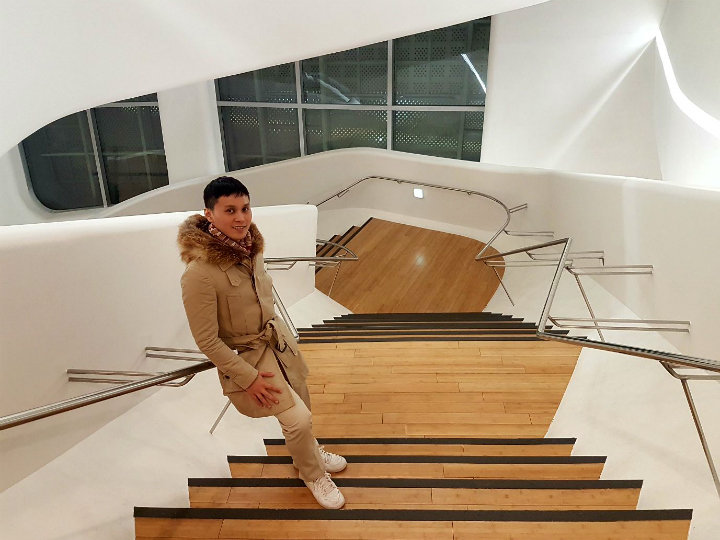 Unique architectural design |
||
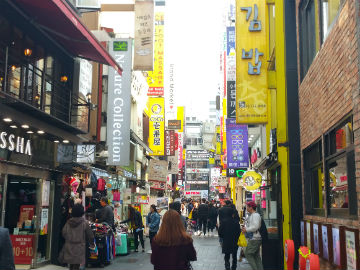 Myeongdong (明洞) shopping district |
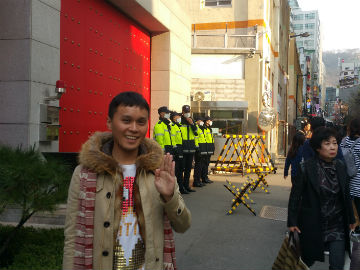 China Embassy at Myeongdong |
||
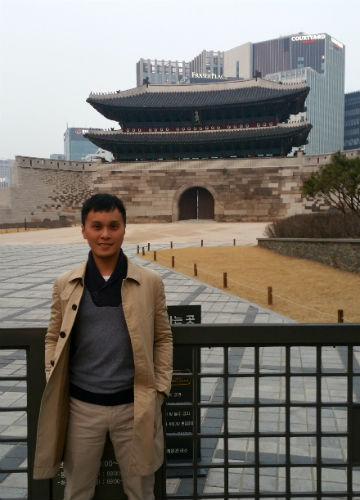 Namdaemun (南大門), or formally Sungnyemun (崇禮門), the Great South Gate is a symbol of Seoul and has been designated as No. 1 National Treasure. Unfortunately, an arson lit fire in February 2008 destroyed much of the structure. |
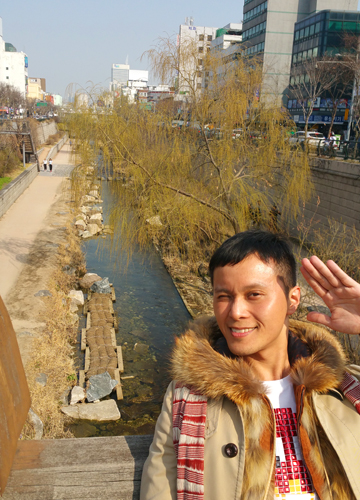 Cheongyecheon, a renovated stream and park that runs through the heart of the downtown area. |
||
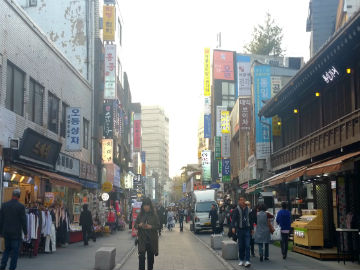 Insa-dong, famousfor its art galleries and traditional cultural souvenir shops. |
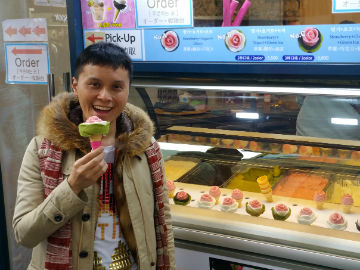 Floral ice-cream |
||
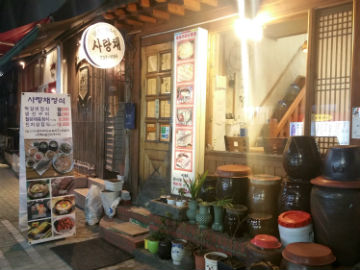 We went for Ginseng Chicken at Insadong |
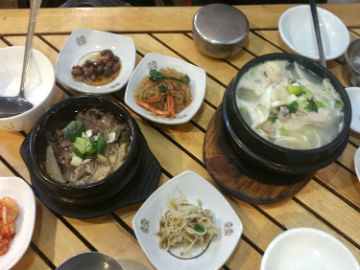 Yum yum |
|
Seoul Palaces
The Joseon Dynasty (朝鮮朝代) built
most of Seoul's most recognisable landmarks, including the Five
Grand Palaces. As most were destroyed during Japanese occupation and
Korean war, most of the temples and palaces are reconstructions. We
only visited two palaces this time, so will leave some for future’s
expedition.
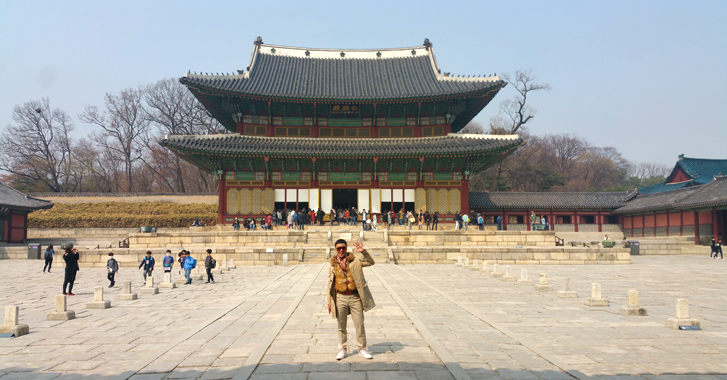 Changdeok-gung(昌德宮) was first built in 1405 and was the seat of power between 1618 and 1896. The buildings have all been recently restored and freshly repainted, creating a dazzling but still elegant effect that got the palace listed as an UNESCO World Heritage Site. Behind me is the Injeongjeon Hall,which was used for major state affairs including the coronation of a new king and receiving foreign envoys. |
|||
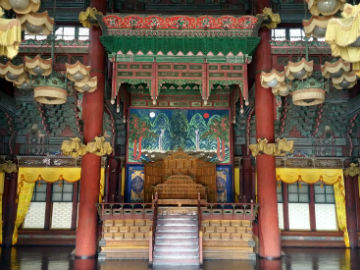 Royal throne in the Injeongjeon Hall. |
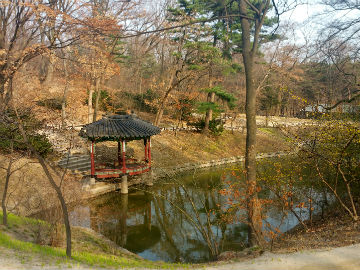 Huwon, the private garden of Changdeok-gung. |
||
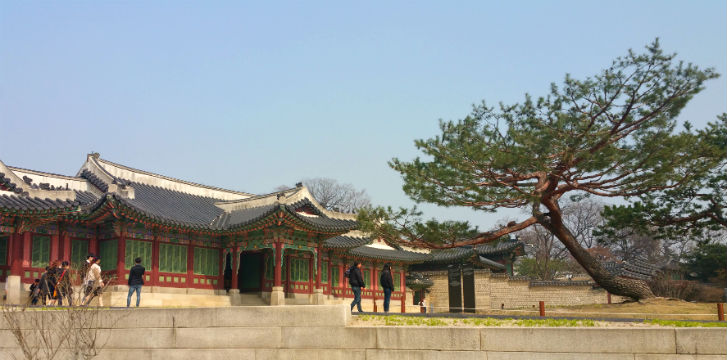 Huijeongdang Hall, originally the king's bed chamber, but became his workplace. The original Huijeongdang was destroyed by a fire in 1917. The reconstructed structure is completely different from the original due to Western influences. |
|||
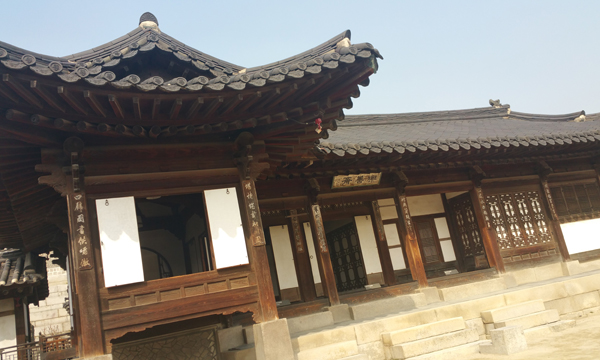 |
The Nakseonjae Complex is a residential compound built in 1847 at an isolated corner of the Changdeok-gung . The Queen then was unable to bear a child for the king, so a concubine was housed here to bear King’s child. The Complex was also a library for the King, and the resident of the King’s grandmother. |
|
All the palace chambers were raised for ground heating system. As a result, traditional Korean prefer sleeping and seating on the floor. |
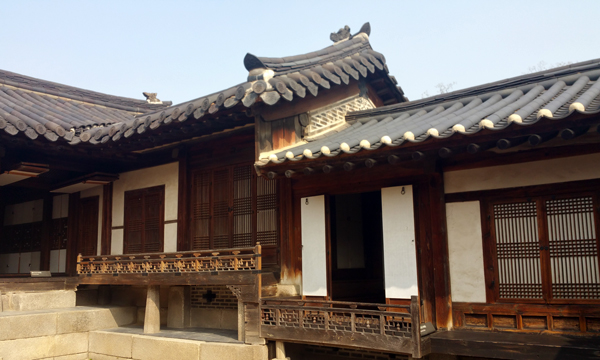 |
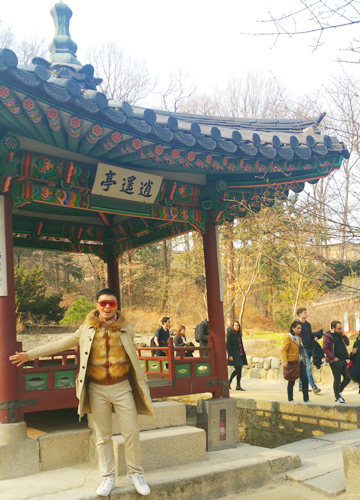 Strolling around the King’s private garden under a mandatory guided tour. |
 The Nakseonjae’s architectural design is more subtle than the Palace as it shouldn't. |
||
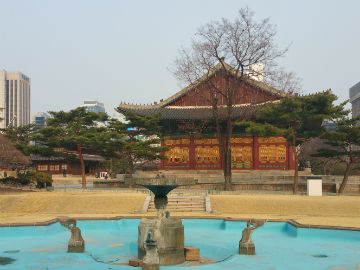 Deoksu-gung (德壽宮), built during the mid-fifteenth century located in downtown Seoul, vividly contrasts to the Changdeok-gung with architectures heavily influenced by Western designs. |
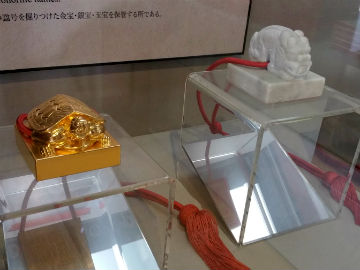 Whilst beside the Chinese Empire, the Joseon Dynastycould only label the king as King and not Emperor or else would invite war with China. The King’s seal is a golden turtle. Yet at early 1900s as China weakened, the Joseon Dynasty labelled their king as Emperor with jade dragon seal. |
|
Jongmyo Shrine (宗廟) |
The main Confucian shrine in the dynastic era designated as a UNESCO World Heritage Site. It is the most famous shrine devoted to the royal family members of Joseon Dynasty. Up until today, the decedents of the Joseon Dynasty reaches over 2 million throughout the 27 generation of kings, so this Shrine remains as an active clan temple with traditional memorial services performed in traditional manor twice a year | ||
 Entrance to his temple must be arranged with a guide tour grouped based on language. Edmund and I were the only tourists registered for Chinese language tour and hence we had our private tour of the venue exclusively and undisrupted by ourselves. Behind us is the main praying temple. |
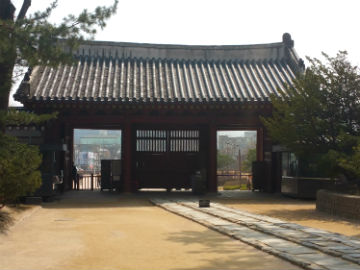 The entrance has three gates: royals entered from the right, nobles from the left, the central gate is only accessible for the spirits. There are three leveled pathway in the middle where King walked on the right, crown prince walked on the left and the middle one was designated for the spirits. |
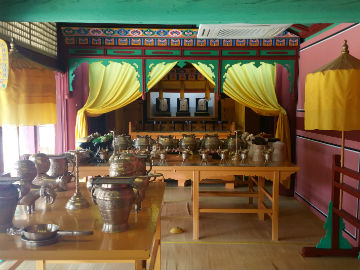 The praying chamber in which the King memorial plate is placed on the west, queen on the middle and concubine the next as west side is considered more noble for the after death. The memorial service is quite similar to that of China under the same Confucius belief. |
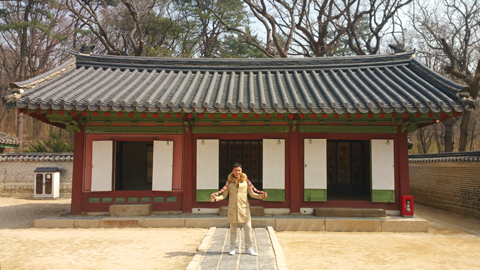 The crown price would shower in this chamber before entering the temple. |
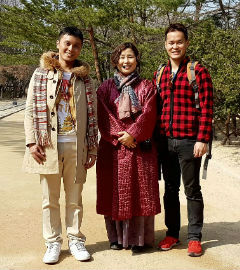 Thanks to her, we enjoyed and learnt a lot of the history and current political stance of South Korea. Thanks! |
Bongeun Temple (奉恩寺)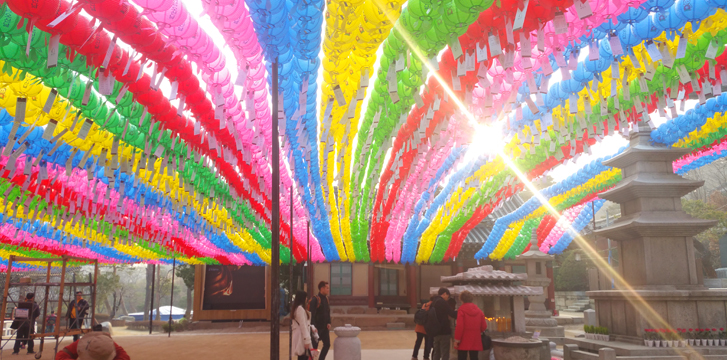 |
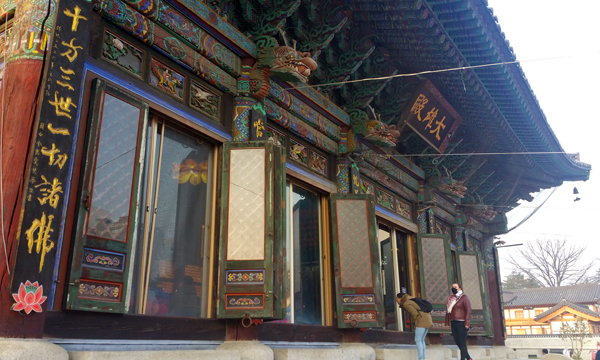 |
Traditionally, this important Buddhist temple with rich history was in a rural outskirt of old Seoul, yet now it is the biggest, richest, and the most visited temple in Seoul as it is at the heart of Gangnam.
|
||
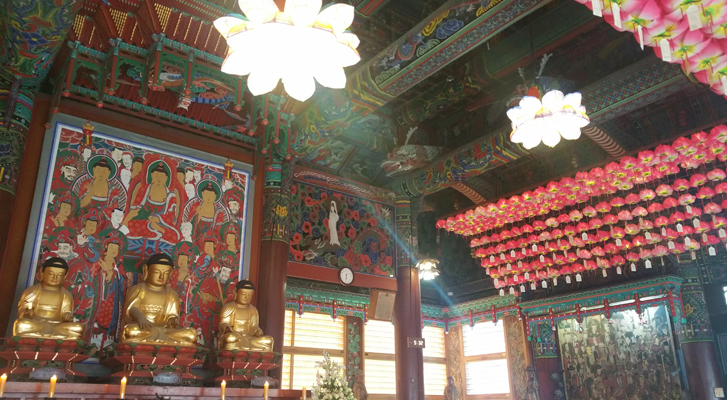 |
|||
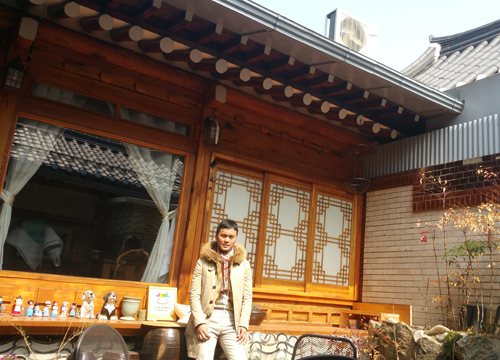 |
We stayed at a hanok, a traditional Korean house, for two days. Hanok shapes differ by region. It is a U-shared with a courtyard in the middle in order to retain heat better.
|
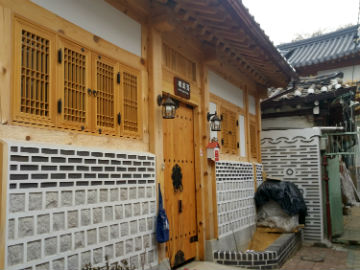 The whole structure is leveled with floor heating so we slept on the ground. |
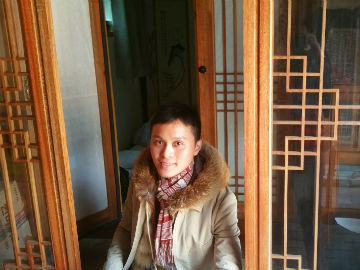 The room has two screen doors to keep the heat inside. |
|
The
Jimjilbang
(汗蒸幕), traditional Korean sauna, is so cool. It can
be a cheap alternative to hotels when it comes to mid-night flights. |
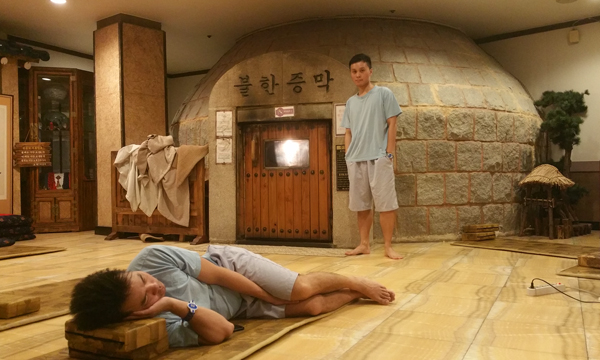 |
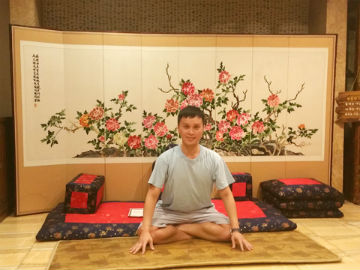 We stayed at Siloam Sauna at Seoul station prior to our midnight flight. We stayed for 3 hours, but should plan for 6 to truly enjoy the relaxation. |
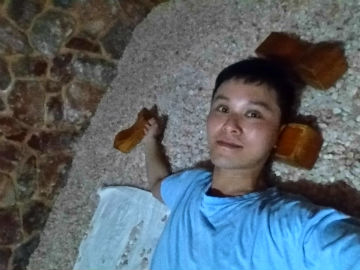 Inside this 37C salt sauna room. The temperature is so mild which I slept there for half an hour. |
| In 2011, I had a 6 hour stopover at Seoul, South Korea. So I had a brief visit of a Korean temple, tried their teas, traditional red bean paste and veggie wrap. Quite satisfied. =P | ||
|
|
|
|
|
||
|
|
|
|
|
|
|

